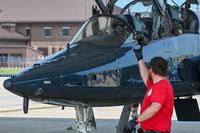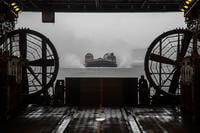Like a bad stain, it seems the V-22 Osprey can't wash away the stigma that it's crash-prone. The main culprit: so-called vortex ring state, a circulating, donut-shaped air flow that can cut a copter's lift, almost instantly. VRS helped down a pair of Ospreys seven years back, killing 23. And those blood spots should be hard to get out. But how accurate is the recent criticism that the V-22 remains dangerously and uniquely susceptible to VRS and blade stall?

After months of flight testing, the Marine Corps and Osprey's makers, Boeing and Bell Textron, said VRS is no more of an issue than for other rotorcraft: something that pilots need to be aware of, but not something they should freak about. And it's not something that only test pilots are qualified to avoid. Contrast that with Lee Gaillard's critical report which depicts VRS as a monster waiting to devour any distracted pilot who wanders outside of a very narrow arrow of the flight envelope.
What's the objective bystander to think? Gaillard makes much ado about how the Osprey is limited to vertical descents of 800 feet per minute (only 9.1 mph, he emphasizes). He says such a slow descent would make the Osprey a fat target in a hot landing zone. But 800 fpm is a meaningless number when separated from horizontal speed; and the report never mentions that the 800 fpm limitation only applies when forward airspeed is less than 40 knots.
Above 40 knots, the limit on vertical descent grows dramatically until, in full airplane mode, the Osprey can, like any airplane, drop like the proverbial brick. NAVAIR says the 800 fpm-descent limit at less than 40 knots applies to ALL Marine Corps helicopters, and that flight testing showed that the V-22 doesn't get close to VRS until 2000 fpm. Furthermore, the V-22 can swoop in from high altitude at more than 200 knots and not start slowing down until it's a minute and a half from the landing zone, minimizing its exposure, says NAVAIR. And it's 75 percent quieter in aircraft mode than the CH-46 and CH-53 it's supposed to replace.
But what does the Navy know? For comparison, look at the UH-60 Black Hawk. A Black Hawk pilot told me he sometimes sees 2500 fpm descents when coming into an LZ doing 60 or 70 knots. That's a vertical speed of 28 mph (only!), but apparently it's no problem for the ubiquitous, beloved and combat-proven Black Hawk. Why would anyone think a V-22 carrying 60 knots forward airspeed would be any worse?
So while critics are all hung up on 800 fpm, it's really no big deal. The Gaillard brief has lots of information, but, in the end, creates more heat than light. At least on this issue. For his work mapping the V-22's VRS envelope, Boeing test pilot Tom Macdonald was honored by the Society of Experimental Test Pilots in 2003. Macdonald wrote the book on VRS and how fleet pilots can avoid it. I met Macdonald, an ex-Navy helo pilot, at Patuxent River Naval Air Station. He didn't seem like the kind of guy who would hide facts that would endanger other pilots or Marines. Ditto for his testing partner, Marine Col. Kevin Gross, who has written a detailed piece about the V-22 and VRS.
Is the Osprey perfect? No, but what aircraft is and who defines perfection anyway? Is it a widow maker as its critics claim? If yes, than it seems doubtful that VRS will be the culprit. But the jury is out. While it seems Osprey critics may be wrong about VRS, that doesn't mean their other criticisms are off the mark. Make no mistake: the Osprey is a historic achievement. But it is crazy expensive and still has flaws such as its lack of defensive firepower and a pressurized cabin, which will seriously reduce its advertised range and speed while carrying troops. The question is whether those issues can be fixed or whether operators can find practical ways to work around them. We'll wait and see what the guys who fly and fight in it have to say.
--Ron Laurenzo, cross-posted at War Is Boring








